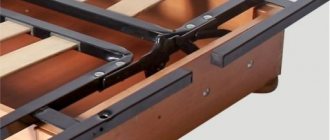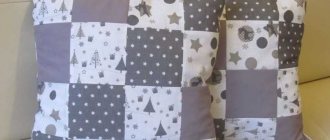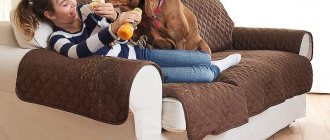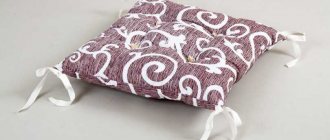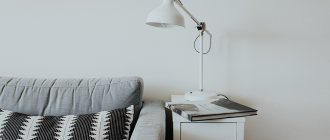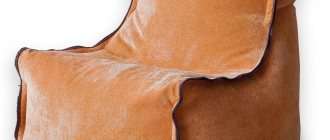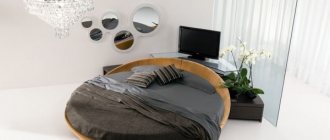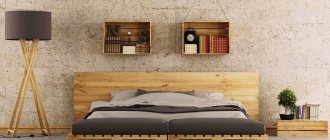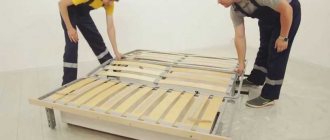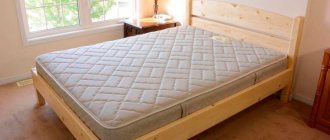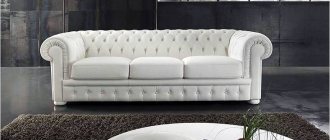An excellent way to complement or change the interior, to make it more comfortable and individual, are decorative pillows.
Making original pillows does not require additional costs, and creating them yourself will result in an excellent decorative element, one of a kind.
From the history of pillows
The making of pillows has a long history. The first products appeared among the ancient Egyptians, only they were used not for comfort and coziness, but as a headrest in order to preserve hairstyles, so such objects were made of wood and metal.
Hard wood pillows
The Greeks were the first to start making soft goods. They were the first to learn how to create all kinds of comfortable pillows, and also decorated them with beautiful embroideries.
Such products were also known in Rus'. Craftswomen worked to create unique pillows, embroidered them with characteristic patterns and even gave them a magical meaning.
The pillows featured various flowers, animals and even people's names.
Sewing the back of the pillowcase
To make the pillowcase neat, be sure to finish the edges of the back side with an overlock or zigzag stitch. Ideally, you can do the same with each square piece, then your product will look its best. But since microfiber or other elastic material hardly crumbles, you can limit yourself to only processing the sides of the back side. After this, you need to fold the side edge of one of the sides twice on the two parts (where they overlap one another). Leave the other three sides open.
Why French children behave well: eight ways to raise them
Smooth and fresh skin: dermaplaning, or why a woman needs to shave her face
If there is little snow, there will be no harvest: December 16 is Ivan the Silent Day
Options for decorating a sofa cushion
When creating a decorative pillowcase for a sofa cushion, fantasize, dream, collect all the decorative elements that you have. There are a lot of ideas for creating such pillows, it all depends on the flight of your imagination.
The following materials are most often used to decorate pillows:
- multi-colored ribbons of different widths;
- yarn of different colors and textures;
- sequins, beads, glass beads, beads, rhinestones and other decorations;
- all kinds of lace;
- application elements;
- embroidered elements;
- ready-made or handmade puffs and so on.
Filling
Now take one of the squares in your hands and fill it evenly with padding polyester, batting or foam.
You should end up with a “lush bun”. Also fasten the fourth side with a pin, having previously made a fold on it. Do the same with all the squares and then close the open sides using a sewing machine.
Crocheted and knitted pillows: ideas, photos, patterns
The ability to crochet or knit makes it possible to make beautiful pillow covers with your own hands. Beautiful patterns will create a unique design and make the room cozy.
Various knitting patterns are used to knit cushion covers. These can be openwork patterns, crocheting from motifs, knitting or purling with knitting needles.
You can also knit pillows of various shapes, for example, in the form of animals, different geometric shapes, etc.
Cushion covers can be knitted from leftover yarn. If you have a lot of little colorful balls and you don't know where to put them, cushion covers are a good idea for usefully recycling leftover yarn.
Let's look at some crochet cover ideas.
One of the simplest and most common patterns is granny square . These pillows are made in a retro style, reminiscent of the old days, when grandmothers could find many similar products in their houses.
Crochet pillow with granny square pattern
Below is a knitting pattern.
Scheme of the granny square pattern
Pillows with openwork patterns look romantic . These pillows will decorate any room. The intricate pattern does not require any additional decor; such pillows are beautiful in themselves. The pattern is called "pineapple". Below is a diagram, following which you can knit such a beautiful romantic pillow.
Crochet pillow cover with openwork pattern
Knitting pattern for an openwork crochet pillow cover
The next pillow is knitted with a flower pattern. For experienced knitters, knitting such a cover will not be a problem. Looks impressive.
Crochet pillow with knitting pattern
You can also knit simple but beautiful cushion covers with knitting needles. Cable patterns are a classic pattern that never goes out of style. The braid pattern can be found not only on knitted sweaters, scarves, but also on pillows. A well-chosen tone of thread for the pillow will make the interior luxurious.
DIY pillows
Knitted pillowcases with knitting needles: braid pattern
Knitted pillowcases for pillows
Below are patterns for knitting patterns with braids.
Knitting pattern with braids
Braid patterns: patterns
Knitting patterns with braids with patterns
You can also knit openwork patterns, checkerboard stitches and other patterns with knitting needles. Pillows in the form of a cushion look original. Knitted pillows are most appropriate in the winter season; they will warm you with their warmth and give a cozy atmosphere to your home.
DIY pillows: knitted covers
Knitted pillow: checkerboard pattern
DIY bolster pillow
You can learn more about DIY knitted pillows here.
Artificial
For those who love practicality, products containing synthetic “fillings” are suitable. Numerous types of artificial fillers allow you to choose the most comfortable sleep accessory. Synthetics make the pillow soft and light, but the filling will have to be replaced after several years of hard service.
Sintepon
The most popular filling for pillows is synthetic winterizer. It is quite durable, but only if washed by hand. An automatic machine can ruin a synthetic padding pillow, and in a year or two you will need to spend money on a new product.
Despite the fact that artificial fibers decrease in volume over time, the quality of relief from the wrinkles of the padding polyester does not change. To purchase a padding polyester pillow for long-term use, you need to give preference to thinner fibers of the material.
Comfort and holofiber
Comfort consists of small soft balls coated with silicone. The synthetic material is wear-resistant and soft at the same time. Thanks to special treatment, ticks and other parasites do not appear in the fibers. Comfort processing is simple and does not require special conditions.
There are no significant differences between comfort and holofiber. The last one presented is also hygroscopic, breathable and does not absorb odors.
With prolonged use, the material clumps into clumps. They can be “broken” again or the required amount of synthetic filling can be added.
Gel
New items in the field of sleep accessories - gel filler. The price of such an invention is high due to its excellent properties. Along with the hygiene of the insert, the gel “remembers” the position of the head on the pillow and adapts each time to its owner. It is difficult to get used to the gel filler, but the massage and cooling effect is obvious. Therefore, using gel pillow filler is advisable only in the summer.
Expanded polystyrene
Sometimes the product is filled with small balls made of synthetic material. The anti-stress filler perfectly supports the body, does not absorb odors and does not contribute to the development of allergies. However, the slight rustling of the balls will not be to the taste of many. In addition, such a pillow cannot be washed.
Polyurethane foam
This synthetic filler is the most common for the manufacture of orthopedic pillows. Various shapes and densities of the material allow you to choose the desired product. To one degree or another, the polyurethane foam filler has a memory effect, which is the orthopedic property of the pillow. The service life is solid - you can use it for 7 years.
Microsphere
The smallest nanogranules of natural minerals fill the item, which has a healing effect. In addition to the main orthopedic effect, microspheres act with impulses on the human body. Pillows do not cause allergies and the development of fungus. Heat is distributed and retained over the entire surface of the device. Pillows are produced in various shapes and for different parts of the body.
Memory foam
The memory pillow has high orthopedic properties. Therefore, most often they are overpriced. The hypoallergenic filler does not require special care and will last for about 5 years. When purchased, the product may have a special smell, but it disappears after some time of use.
The disadvantages of such an orthopedic device include poor air transmission through the material, as well as changes in the hardness of the pillow depending on the temperature in the room.
Patterns and diagrams of sofa cushions
Pattern of a square sofa cushion
Pattern of a figured pillow using the patchwork technique
Pattern of the pillow-toy “Bird”
Pattern of a children's horseshoe pillow
Pattern of a decorative sofa cushion
Instructions:
- Determine the required width and height of the planned pillow. Add 1 cm on each side. Fold the fabric in half, cut out the desired size, sew open edges. Leave a hole approximately 10 cm long unstitched.
- Fill the pillow with padding polyester. The amount of padding polyester should be such that it is not heavy. Sew the hole closed with a blind stitch. The sofa cushion is ready. Make as many items as needed.
- As for decoration, you can sew an original pillowcase for it, decorate it with buttons or beads, and also do embroidery.
How to sew a pillow: diagrams and instructions
Standard pillows
Standard sewing patterns are the simplest and do not even require a pattern. In fact, these are two squares of fabric that are simply sewn together. Usually everything is done by eye, including the amount of filler.
The step-by-step instructions look like this:
- Two squares of the same size are drawn on the fabric. You can do this using a prepared paper template.
- Three sides need to be sewn. You can do this with a sewing machine or a small stitch with a needle and thread.
- Filler with arbitrary density is stuffed inside.
- The side is stitched.
If you plan to use the sofa cushion for sleeping or frequent rest, you can sew in a zipper. This way the pillowcase can be quickly released for washing.
Sectional cushions
A sectional sofa cushion differs from a standard one in that a sewn-in stiffener rib is installed in the middle. It is located perpendicular to the base, so they have a high density. Because of the structure, they basically cannot sit down. The technology is no different from the standard one.
Pillows with buffs
A puff is a three-dimensional pattern on the surface of a pillow, which is often used to decorate the surface of the fabric. As a rule, they are not comfortable for sleeping and play an exclusively decorative role. Embroidery comes in different shapes and types. Ruffles, wave patterns, and gradients are often used.
DIY sofa pillows with puffs should be made only from durable fabric. Suitable for silk or other glossy fabrics such as satin. In addition, silk fabrics can be replaced with various types of linen fiber or cotton.
Despite the apparent complexity of such patterns, they are easy to sew. You need to make a template from paper with the exact pattern you want to obtain. After this, the fabric is grabbed and stitched by hand. In this case, the drawing will turn out neat.
Pillow toys
Beautiful pillows for children are the most difficult to sew, as several separate fabrics are used. But you can surprise your child with weekly pillows for every day.
To make sure your child likes the pillows, you can use the sketches presented below. All you need to do is print them out or draw them on paper. For greater accuracy, you can make a cardboard template that will allow you to make several identical beautiful pillows.
For decoration, you should buy toy eyes and ears at a craft store. Children of preschool and primary school age will like these pillows.
Quilted pillows
The name "quilted" is associated with the specificity of sewing, since it is completely covered with stitches. And this type of pillowcase has a number of advantages. They practically do not lose their shape, as they are firmly fixed with threads. In addition, they can be used for sleeping.
You can fill it with any stuffing, since even with constant rest on the pillow, it will not wrinkle or flatten.
The classic option is parallel stripes or squares that look discreet but cute. Stitches can also be curly. For example, birds, animals, facial features can be embroidered, as in the photo.
It is better to make such original decorative pillows with your own hands on a sewing machine to ensure an even and beautiful stitch.
Pillow bolsters
Bolsters, unlike square pillows, require only one piece of fabric and two inserts on the sides. The easiest way to make them is not from purchased fabric, but from an existing blank. Old jeans are best. Trousers and jeans will be comfortable, since they already have the desired shape and you won’t have to resort to a sewing machine. If you don’t have old trousers, you can use regular linen. Since the padding must be dense, the seam must be strong and rigid.
To always have access to the filler, you can make fasteners in the form of ties at the end and stuff it like a punching bag. The bolsters are used as armrests and headrests.
Knitted pillow
How to make a pillow entirely with your own hands? For those who like to knit, you can make your own pillowcase. All you need is very strong threads of good quality and a little free time.
The advantage of such a pillow is its ability to decorate. You can make the pillowcase white and paint it with dyes specifically for yarn. They can withstand washing and do not fade in the sun.
Latex filler can be used as padding. Unlike synthetic fluff, it will not crawl through the wide pores of the ligature.
A knitted pillow can be decorated in any way you like. Including, you can make beautiful children's pillows and head bolsters.
Types of fabrics
A cover or pillowcase (if used for sleeping) is the main part, the “face” of a soft pillow. As a rule, it is made of durable fabric that will withstand many washes and last for many years. For homemade pillows, improvised materials are often used: from old clothes (T-shirts, jeans), blankets or patchwork scraps. Although synthetic fabrics have taken over the textile market in recent years, it is better to choose natural ones:
- Silk. Delicate but skin-friendly material. Silk slipcovers are difficult to maintain, but they go perfectly with a luxurious, classic design.
- Linen. The rough texture of flax suits the country subspecies. The material wrinkles easily. This is its main drawback, but it is hypoallergenic and pleasant to the touch. In the summer heat, linen will give you a feeling of coolness, and in winter it will warm you up.
- Cotton. Inexpensive natural material that is easy to care for. In terms of stylistic consistency, cotton slipcovers are easy to integrate into almost any interior.
- Wool. The covers may look rough, but the material will keep you warm in the cold winter. It's nice to sleep on these pillows.
When choosing fabric for a cover, it is important to follow the rules of its compatibility with the filling:
- For “loose” fillings, thick fabric pillowcases are needed.
- For delicate stuffing (swan down), the same delicate fabric is selected, which will allow you to feel the filling.
Popular textile options for pillow covers include fleece, felt, teak, jacquard, satin, percale, cambric, twill, and tapestry.
Polyester is considered one of the cheapest and most durable materials. This synthetic fabric is not suitable for sewing covers. It quickly wears out and loses its shape. It is not recommended to use old polyester T-shirts for sewing pillowcases.
Decorative pillows in different styles
A stylish and self-sufficient accessory will perfectly complement any interior if you choose it correctly. Although pillows can fit into almost any design, we offer you some of the most striking options.
Elegant Provence
Textiles are one of the main accessories of Provence, and romantic pillows with ruffles and lace will fit here like family. Choose pastel shades and small floral and plant patterns.
Hand embroidery looks especially impressive, which can be repeated on other elements: curtains, tablecloths, bedspreads, linen, napkins and potholders.
Cozy Scandinavian style
Cozy Scandinavian minimalism gravitates towards an abundance of pillows, blankets and other symbols of the home. Use coarse textured fabrics, large knits, and unusual figured pillows. Any handmade item in the Scandinavian style is especially organic.
Industrial loft
It is the accessories that give individuality to a deliberately simple and rough industrial loft. Bright multi-colored pillows on a simple plain sofa would be appropriate here. They go well with bean bag chairs and other interesting accents.
Extravagant pop art
Catchy and flashy pop art especially loves prints, provocative inscriptions and rich colors. Use all this on decorative pillows - and they will organically fit into a bold and extravagant interior.
Luxurious classic
Luxurious classic interiors feature traditional shapes and expensive materials. Complete a conservative sofa with velvet pillows and gold trim. And for harmony, you can repeat individual elements and motifs on the curtains.
Quirky boho
Eclectic and whimsical boho combines everything incongruous. Therefore, the most colorful and scattered decorative pillows are surprisingly organic here. Such accessories add unique chic to the interior.
Modest minimalism
Laconic minimalism does not accept excessive decor. All decorations should be practical and serve some function. Therefore, unusual accent decorative pillows will easily come to the fore when creating minimalist interiors.
LiveInternetLiveInternet
—Categories
- LIFE AS IT IS (4)
- EMBROIDERY (8)
- beads, sequins (2)
- video-mk (2)
- machine embroidery (free-motion) (2)
- on clothes, bags, etc. (4)
- hand embroidery (2)
- photo-mk (1)
- CROCHET (312)
- video-mk (11)
- collars (15)
- base pattern (1)
- hats (73)
- girls (58)
- jumpers, jackets, cardigans, coats (30)
- for home (11)
- for overweight (3)
- women (58)
- dolls, toys (1)
- kids (1)
- boys (8)
- my work (4)
- men (8)
- socks, footwear, slippers (2)
- blankets (9)
- poncho (1)
- knitting tools (3)
- miscellaneous (3)
- tablecloths, napkins (17)
- bags, clutches (5)
- knitting technology (12)
- tops, tunics, blouses (22)
- patterns (30)
- photo-mk (2)
- flowers (5)
- shawls (15)
- scarves, stoles, snoods, shirtfronts (27)
- skirts (21)
- KNITTING (187)
- video-mk (14)
- collars (1)
- base pattern (1)
- hats (28)
- girls (22)
- for overweight (1)
- women (39)
- kids (1)
- boys (2)
- men (9)
- socks, footwear, slippers (2)
- processing of knitted products (2)
- blankets (1)
- knitting tools (3)
- miscellaneous (2)
- knitting technology (23)
- patterns (62)
- photo-mk (1)
- flowers (1)
- shawls (3)
- scarves, stoles, snoods, shirtfronts (44)
- skirts (1)
- FOR PLUS (4)
- clothing models (2)
- losing weight correctly (1)
- OTHER KNITTING (0)
- HEALTH (33)
- video (2)
- IDEAS (12)
- interior, design (6)
- New Year (6)
- FAMOUS PEOPLE (2)
- ART (7)
- other directions (4)
- photos (1)
- HISTORICAL (1)
- COOKING (1)
- MY FAMILY (2)
- MUSIC (2)
- video (2)
- TRAINING (2)
- working with settings on LiRu (1)
- old textbooks (1)
- ANNOUNCEMENTS (3)
- CONGRATULATIONS (1)
- USEFUL TIPS (13)
- repair, construction (1)
- note to the hostess (5)
- PROSE (5)
- PSYCHOLOGY (97)
- relationships (18)
- video (4)
- family matters (5)
- children's (25)
- spiritual (7)
- women's (8)
- health (2)
- man and woman (11)
- positive, rituals (6)
- parables (2)
- work on yourself (20)
- parents, relatives (5)
- fairy tales (1)
- finance, success (2)
- HANDCRAFTS (39)
- masterpiece gallery (4)
- for home (8)
- toys, dolls (6)
- New Year (12)
- photo-mk (1)
- flowers made of fabric and other materials (8)
- WEDDING THEME (6)
- accessories (5)
- dresses with embroidery (1)
- decorations (2)
- veils, veils, etc. (4)
- POEMS (10)
- BAGS (2)
- stitched (2)
- YOUR IMAGE (12)
- evening fashion (2)
- video-mk (3)
- beautifully tie scarves (1)
- beauty (1)
- clothes for a full figure (2)
- hairstyles, haircuts (1)
- stylist tips (3)
- body type (2)
- SEWING (151)
- lingerie (14)
- video-mk (32)
- collars (7)
- hats (10)
- children's (13)
- for home (7)
- women's (20)
- cut and sew together (16)
- cutting and sewing trousers (4)
- cut directly on fabric (2)
- cutting, modeling (15)
- my work (1)
- men's (8)
- workplace organization (5)
- decoration, decoration of things (22)
- model parade (9)
- sewing accessories (13)
- miscellaneous (4)
- clothing repair (2)
- sewing technology (28)
- photo-mk (13)
- flowers (1)
- sew and alter (6)
- SEWING. Video lessons Paukšte (427)
- miscellaneous (58)
- trousers (9)
- collars, hoods (17)
- children (11)
- cutting and sewing (125)
- cut directly on fabric (38)
- prototyping (4)
- modeling (18)
- men (3)
- full figure (21)
- review of ready-made items (152)
- answers to questions (2)
- coat (24)
- psychology (6)
- system 10 measures (22)
- sewing technology (60)
- decorations (3)
- hats, bonnets, (1)
- ESOTERICA (8)
- about zodiac signs (5)
- horoscopes (1)
- palmistry (1)
- THIS IS INTERESTING (15)
- HUMOR, POSITIVE (45)
- video (13)
- cat matrices (2)
- jokes (12)
- stories (12)
Patterns
Before you make a decorative pillow with your own hands, you should draw a pattern. This will make the work much easier and allow you to achieve the desired result.
It’s easy to draw a pattern for a classic-shaped pillow yourself. To do this, you need to decide on the size and draw a geometric figure on paper. The fabric is cut taking into account the seam allowance.
Original decorative pillows especially require a sketch and pattern. You can get ideas for creativity by looking at photo galleries of DIY decorative pillows on specialized websites.
You can copy the templates you like. Having a detailed pattern will make the work easier and allow you to make several products of the same shape without extra effort.
Assembly
Place the front of the pillowcase right side up (squares facing up). Place the two back parts on it (wrong side up) so that one slightly covers the other, as was provided in advance. Pin the sides together around the perimeter (you should still have a hole in the middle). Make sure all sides are joined correctly and the stitching goes through without touching the side squares. Sew the pinned sides and then turn the piece inside out.
In the form of animals and toys
Covers in the shape of animals are sewn under similar pillows. You can use the same template for work. The fabric is selected to match the color of the animal. For example, it is easy to find striped material for a zebra. “Predatory” prints (leopard, tiger, lion) are still popular. If there is no suitable material at hand, then patterns of giraffe skin or crocodile skin can be obtained by painting. For simpler animals (fluffy bunnies, bear cubs, dogs, cats), use soft plush and felt that is pleasant to the touch. Animal eyes can be purchased ready-made or replaced with buttons, large beads, or cabochons.
Sewing squares
Place the two square pieces on top of each other, aligning the sides. The front side of both materials should be on top. Then make a fold in the middle of one side and secure it with a pin.
"Dad is offended." Agata Muceniece about her relationship with Priluchny after the divorce
The money tree pleases with lush flowering: my secret is in caring for the leaves
Lost weight: what Sofia Tarasova sacrificed for the sake of “VIA Gra” (new photos)
Do the same with the other three sides. In a similar way, fasten all the other squares that are provided for sewing one side of the pillowcase. All fastened sides should be machine stitched.
Features of work
When sewing pillows, it is important to take into account the small nuances of working on this decorative item. The product consists of a pillowcase, filling and decorative cover. The top cover is made so that it is easy to remove for cleaning or washing.
When cutting, the size of the cover should be made a couple of centimeters larger than the pillowcases.
When considering how to sew decorative pillows with your own hands, it is worth considering these features of the work.
How to choose fabric, filling and accessories
Before sewing a beautiful product for decoration, including a pillow, you should carefully consider its filling and the material from which it will be made. It is important to choose fabrics that will be as easy to care for as possible. Moreover, the material should not become electrified during use and attract dust. Ideal for this would be:
For a more budget-friendly and original option, you can use old clothes or parts of them. The pillow will be in a patchwork style and no one will even guess that it contains old T-shirts, sweaters and pants.
Square decorative item made of silk with an oriental motif
Filler
If you have no idea what to stuff your future product with, then you need to familiarize yourself with the list of popular materials. You should choose those compositions that will not begin to clump after a certain time. Based on this, padding polyester and cotton wool disappear immediately. You should also not use feathers or down for these purposes, as these materials do not hold their shape well and are suitable for sleeping products.
The most preferred options are:
Accessories
To sew a decorative pillow yourself by hand or on a machine, you will need threads of a certain color and number. Usually from 40 and above. In order to embroider on the product you will need floss. If the base of the pillow is knitted, then use almost any yarn. If the product cover is removable, it may require buttons or a zipper.
How to decorate a finished pillow in an original way
When you want to update decorative pillows with your own hands, but don’t want to bother with sewing a product from scratch, our quick tips for transforming already finished products beyond recognition will come to the rescue!
Method one: airy heart made of roses
For work we need a pillow, fabric that does not require cutting, scissors and a needle.
We cut out circles from the selected fabric (not necessarily even, even if they are slightly different in shape) with a diameter of about eight centimeters. Next, we take one piece by the middle, gather it together, forming folds as in the photo, fix it with a couple of stitches and sew another circle at the bottom, forming a lush bud.
We continue to sew circles to the rose until we get a flower of the desired size.
Prepare the rest of the roses in the same way.
Sew the flowers to the front side of the pillow, starting with the outline of the heart.
We arrange the parts more closely, without leaving large gaps between them. We gradually move towards the center in a spiral. We fix the thread and hide the tail. The decoration for the sofa pillow is ready!
Method two: application
It would seem primitive! But look how an ordinary pillow was transformed in just half an hour! The pillow can be decorated with colorful flowers, animals, hearts, butterflies - it is not at all necessary to achieve natural colors. This pillow will make even the grayest and rainiest autumn a little warmer and more comfortable.
Method three: tapes
Ribbon, whether satin or fabric, can quickly transform any boring, plain-colored pillow! Experiment with the width and types of bows - it's easy and fun!
Method four: buttons
Bright and pastel shades, large and small – buttons will always decorate a finished pillow, especially if you collect interesting pictures from them.
Method five: pompoms and tassels
The same rule applies to pom-poms as to buttons. Experiment and use your imagination! :)
Seamless pillowcases
Making a beautiful interior item without a needle and thread is quite possible.
- Take a cloth or a beautiful large scarf, wrap it around the pillow and tie the edges into a knot. A flower made of fabric or a colored button can slightly enrich a simple knot.
- In a similar way, wrap the pillow with fabric on four sides, and glue the last free edge with glue.
- Simple and creative - a pillow with ties. From the main size of the canvas we leave another 10-15 cm of margin on each side. We cut them into strips, they will be our ties, instead of seams. Also, these may not be small ties, but large bows.
Seamless pillowcase
Cool DIY pillows: ideas, photos, patterns
Not only children, but also adults are crazy about unusually shaped pillows. Many people like to decorate their homes with cool, unusual, creative things. Pillows in the shape of donuts, with smiley faces, etc. look great. There are no limits to your imagination; you can make a pillow in any shape, any color. And our ideas will serve as inspiration for you.
If you are good at sewing such pillows, you can give one of your friends a souvenir for the holiday. If guests come to you, they will definitely pay attention to the original handmade pillows.
Below you will find photos of original and cool pillows, as well as patterns for them.
Ideas for original decorative pillows with your own hands
Ideas for original DIY pillows: round pillow in patchwork style
Ideas for original decorative pillows with your own hands: rose pillow
Ideas for original DIY decorative pillows: knot pillow
Ideas for cool DIY decorative pillows
Cool DIY pillows
In addition to standard small pillows, there are hug pillows. These pillows are large in size, thanks to them you can sit comfortably in an armchair or on the sofa.
Hug pillows
You can also make your own maternity pillow. It can be in the form of a long roller or a horseshoe. Thanks to this pillow, a pregnant woman can sleep peacefully and comfortably. After all, pregnant women’s sleep is not always restful; swelling and heaviness of the abdomen contribute to discomfort.
Maternity pillow
If you fill a pillow with small balls, it will become an anti-stress pillow. You can relax while holding the balls in your hands, and the soft fabric of the pillow helps relieve stress even more.
Important: If you want to make your pillow not only comfortable, but also useful, fill it with aromatic dry herbs. During insomnia, such a pillow will be an excellent helper. Fragrant herbs promote relaxation and a quick transition to sleep.
Patterns of sofa pillows
Pillow pattern
Pattern of an original pillow
Materials and tools for work
To sew decorative pillows, you need to prepare fabric, stuffing material, threads, needles, scissors, a zipper, an iron, paper for the pattern and the necessary decor. Of course, things will go faster if you know how to use a sewing machine, but if not, it doesn’t matter. You can sew everything by hand, using short stitches for the inside seams. To sew on external parts, you can use not only ordinary threads, but also floss or yarn.
Sewing tools
When mastering a master class on sewing a pillow, you need to select the main components.
Fabrics
How to sew a durable, practical, beautiful and original pillow largely depends on the fabric. Choose a material with which you are comfortable working and with which your ideas are consistent. It can be linen, cotton, silk, calico, flannel, felt, knitwear, burlap, satin, crepe satin, denim and fleece.
It is better to choose natural fabrics for pillows
Furniture upholstery is perfect for these purposes. It is not recommended to use stretch fabrics, which can turn all your efforts into a stretched misunderstanding.
Natural fabrics
But you don’t have to immediately run to the fabric store; sometimes you can find brilliant ideas without leaving home. Do you feel like throwing away an old, worn sweater or a favorite shirt that is torn? There is a way to make an original pillow out of them. Old clothes, jeans, scraps of fabric are excellent materials for this.
Needlewomen who know how to knit and embroider don’t have to worry about the design of their creation at all - such covers will be the warmest and brightest.
Padding
Nowadays, there are excellent hypoallergenic materials for stuffing that do not lose their shape and elasticity over the years, which are ideal for stuffing any pillows. These include:
- synthetic fluff;
- fibertech;
- Holofider.
Sintepon and foam rubber tend to lose their shape a little, but they are quite suitable for decorative pillows.
Pillow fillings
You can also use fur or pieces of fabric for stuffing. Especially if the pillow is not evenly shaped, has a large volume and is made of rough material.
Separately, we can say about silicone granules. Not only do they not get wet, are easy to clean, and can be filled through a small opening in the pillowcase; pillows with such filling can be called anti-stress. Touching them relaxes and ensures a carefree sleep.
Natural down and feathers can also be used, but they are not as easy and convenient to work with as synthetic materials, and they can also cause allergies. The advantages include the long service life and disinfecting properties of down, contrary to the prevailing myth that down and feathers are keepers of dirt and parasites.
Feather pillow
Work on creating a decorative pillow
It’s better to prepare everything for work in advance.
In addition to the fabric, you should stock up on:
- scissors,
- life-size patterns,
- a piece of dry soap or chalk,
- needles,
- threads,
- sewing machine,
- decorative elements.
Instructions:
- First, overlock 2 pieces of curtain fabric. Sew them together and iron them well. Using a chalk and ruler, mark the fabric from the wrong side. Draw the fabric into 2.5 x 2.5 cm squares and apply the puff pattern you like.
- Fold the fabric in half and mark the middle with a pin. From one end, count the number of marks, get as close to the middle as possible, step back 1 cm from the last square, cut the fabric and process the cut with an overlocker.
- Fold the fabric in half again, but with the markings facing outward. Connect the middle and all parallel lines with pins. Stitch and remove pins. When the workpiece is ready, you can begin forming the buffs.
- The puffs are assembled by pulling the threads according to the pattern. When you complete the 1st tie, do not forget to secure it. Thus, make as many buffs as necessary.
- You can sew a beautiful button into the middle of the finished pillow. Stuff the product with padding polyester and sew.
Cushion
The furniture cushion that complements the sofa usually has a simple geometric shape. Most often it is a rectangle.
Such items are subject to wear and tear during use faster than the sofa itself. The opportunity to buy a similar pillow is not provided by furniture manufacturers.
Therefore, there is a need to sew such a pillow yourself. This is a simple job, most of the success of which lies in the correct selection of material for the cover.
If possible, the fabric should be found similar to the upholstery of the sofa. If there is no such fabric, then you need to think through the design of a new pillow so that it fits organically into the interior.
In any case, the texture should match the upholstery of the sofa, and the color should be in harmony with the design of the room.
The easiest way to copy a factory copy is to rip open the old one and measure the cover.
Using these measurements, draw a drawing, cut and seam the parts of the new product.
Processing the cut edge of the pillow cover fabric
Before sewing the seams of a decorative pillow cover, you first need to overcast the edges of the cover “in a circle” with an overlocker. Then fold the fabric with the right side inward and machine stitch the side seams. Set the stitch length to a medium size; stitching too often can destroy the fibers of the fabric. It is not necessary to select threads according to the color of the pillow fabric, but it is advisable. Do not use threads that are too thick; this will not make the pillow cover stronger, and the stitching in the seam with such thread will be worse. In the future, such a “weak” seam will “diverge” and the side seams will become very noticeable.

